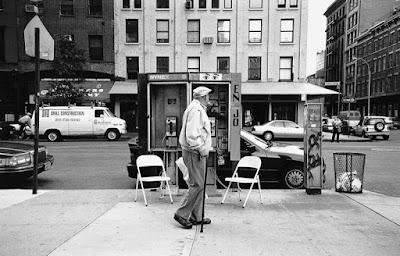During the 1990's, Calle traveled to various parts of the world and recorded her experiences and those of the people she met there. In 1996 she visited Jerusalem and based an entire exhibit on the Orthodox Jewish tradition of the eruv, calling it Public Places-Private Spaces. The description of an eruv is as follows:
"The eruv is a physical and symbolic enclosure created by stringing galvanized steel wire from poles in and around a Jewish community. This practice is used as a way of stretching the Talmudic law that prohibits the transfer of objects outside of the home on Sabbath (every Friday at sun down until the following day at sun down) by defining the space within the eruv as “home.” The ritual of honoring the eruv is quite involved and in Jerusalem it includes a weekly assessment by an “eruv inspector” to insure that the lines have not been damaged. If any gaps are spotted, the repairs must be completed before the beginning of Sabbath, otherwise an announcement is made by rabbis throughout the city that the space is not protected." (source)
In addition to photographing the giant eruv in the middle of the city, Calle asked both Palestinian and Israeli residents to take her to places that were meaningful to them and describe why. Despite massive conflict between these two groups, this frames the locations in a personal context rather than a hostile and political one. The anonymous descriptions were displayed alongside a map of Jerusalem in the Collection of Musée d'art et d'histoire du Judaïsme, Paris.
eruv (1996) by Sophie Calle
In 1992, Calle traveled across America in a collaboration with the photographer Gregory Shepard. No Sex Last Night is a film about the experience of traveling with a stranger and begins with Calle's burial of her close friend Herve Guibert. The journey ends at a drive-through wedding window in Las Vegas, where the two artists are married. The odd dissonance in their relationship can be seen in the following video clip, where they speak aimlessly to each other through the camera.
The two lived together for a short time after the marriage, but broke up when Calle discovered letters addressed to another woman called "H." The movie is an uncomfortably close look at the relationship between Shepard and Calle and displays two different viewpoints on the meaning of the journey and where they think they will ultimately end up.
Calle traveled to New York and developed a friendship with writer and filmmaker Paul Auster, who came up with a guide for her to live by during her time in the city. The sarcastic title was Personal Instructions for SC on How to Improve Life in New York City (Because she asked...), which later resulted in The Gotham Handbook (1999). Instructions included are "smile at and talk to strangers, distribute sandwiches and cigarettes to the homeless and to 'cultivate a spot.'" (source) Calle accepted the challenge and commandeered a phone booth on the street, painting it green and providing friendly services to random passerby. Calle cleaned the booth and restocked it with water bottles, cigarettes, flowers, cash, and notepads on which strangers could write their opinion of the project. She documented the entire experience and compiled it to create The Gotham Handbook.
Image from The Gotham Handbook (1999) by Sophie Calle
In my opinion, these later pieces are her most interesting. As Calle grew older, she relied less on shock value and exploitation and created work that was both sincere and concerned. While still self-centered, her work reflected on the disenfranchised and gave a voice to people who are often overlooked.



No comments:
Post a Comment